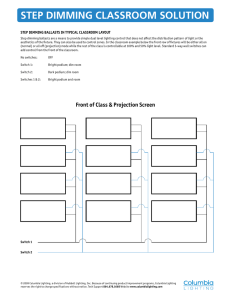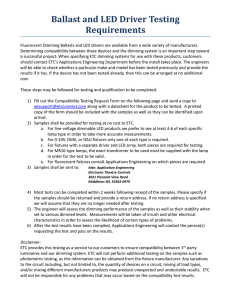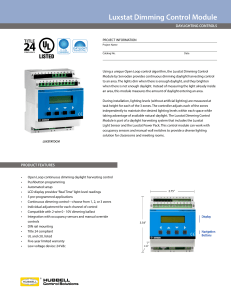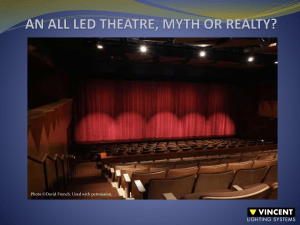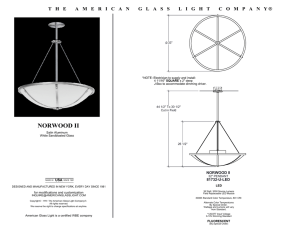Dim and dimmer. - Lighting Research Center
advertisement
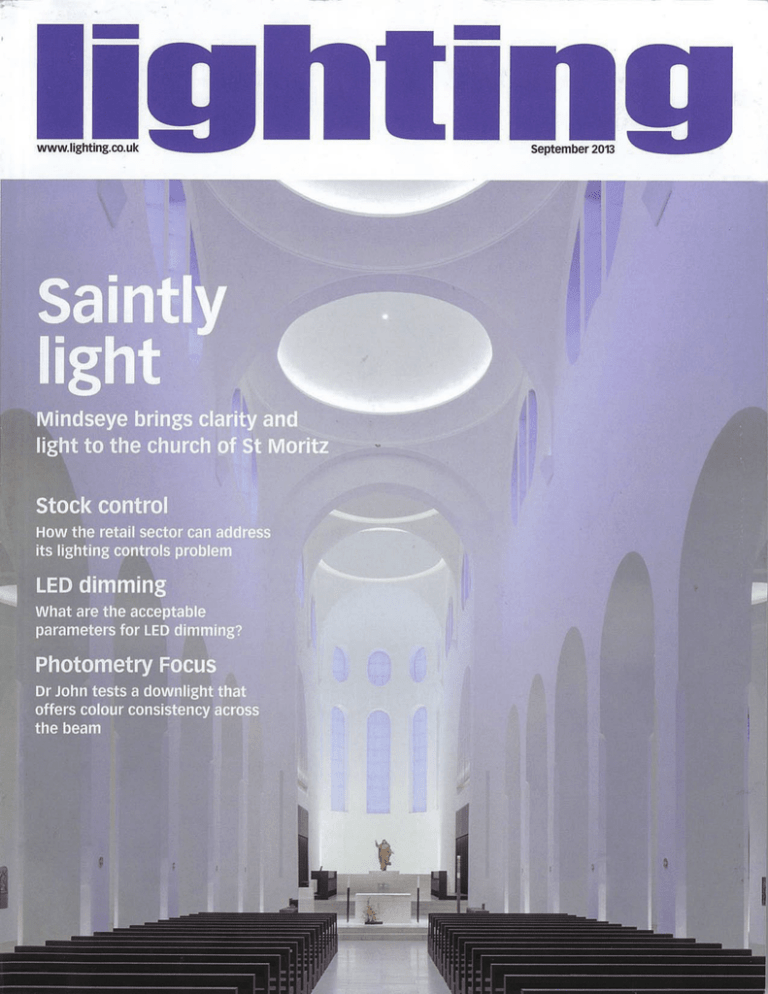
35 1 PARAMETERS OF LED DIMMING LIGHTING CONTROLS When it comes to dimming LEDs, confusion reigns: they don't always combine well with legacy control systems and there is no set definition of what acceptable 'dimming' really is. Amanda Birch looks at a study that aimed to work out what people want and sets parameters to help manufacturers achieve it ighting designers and manufacturers are all too aware of the incompatibility issues that can sometimes arise when combining LEDs with existing dimming technology. In residential and hospitality LED retrofit projects, where dimming creates that all-important mood and atmosphere, results can sometimes fall short of expectations. The fault is not with the LED, which is easy to dim when using modern control protocols; rather, it is that there are no set parameters for acceptable dimming and it can be problematic getting LED lamps and luminaires to conform to existing phase cut dimmers, which don't always work well with the technology. L Non-standard practice James King, sales director at Mode Lighting UK, who heads up the controls side of the business, thinks the root of the problems are clear. "If there's no general guideline or consistency within the market of what we want to achieve," he says, "then you will continue to have a situation where a particular LED lamp is specified and next time a lighting designer or client www.l ighting.co.uk uses what they believe is similar, they get a completely different performance from it. " He praises research recently conducted by the Alliance for Solid-State Illumination Systems and Technologies (ASSIST), which aims to provide a recommended definition for LED dimming in residential and hospitality retrofit applications. ASSIST is a unique collaboration between the lighting industry and academia, and part of the Lighting Research Center based at the Rensselaer Polytechnic Institute in Troy, New York. In collaboration with its members, ASSIST addresses the common barriers faced by solid-state lighting. It is an independent body that tests products in a neutral way and provides guidance to the lighting industry. What makes it particularly unusual is its ability to test three key areas: the technological effects; the human factor effects; and the lighting design. It is important that all three areas are tested to get a balanced view. If people don 't like a product, even though it may be the best technology available, it won't necessarily get adopted. .,. September 2013 liohting 36 ~ SLL CONTROLS GUIDE CIBSE sets up lighting controls task group p41 1 LIGHTING CONTROLS PARAMETERS OF LED DIMMING ASSIST'S DIMMING RECOMMENDATIONS ............................................................................................................................... DEAD TRAVEL This occurs when there is no change in light output from a dimmable lamp despite a change in the dimmer setting. The ASSIST report recommends that dead travel is limited to no more than 10 per cent at the top, bottom or middle of a dimmer setting. DIMMING PROFILE This is the rate of change of light output as a function of the dimmer setting, also known as the dimming curve. ASSIST concluded that as long as the dimming profile is monotonic and meets the dead-travel and range requirements, no limitation on the detailed shape is recommended. FLICKER Dimmable lamps should produce an acceptable rating greater than zero for frequencies equal to or greater than 100Hz. MINIMUM LIGHT LEVEL Until lamp and dimmer combinations are able to achieve lower minimum dimming levels, dimmable products should reach a minimum light output of no more than 5 per cent of the maximum output to meet users' expectations. MAXIMUM LIGHT LEVEL Alamp dimmer combination's maximum light output should be no less than 90 per cent when operated at rated input voltage. NOISE Acceptability to end users will depend on the application. A methodology for measuring audible noise from a lamp or dimmer has not yet been clearly defined ; until it is, ASSIST recommends using established test procedures from the International Organisation for Standardisation. SYSTEM EFACACY The luminous efficacy of a dimmable lamp should be measured when operated at maximum output. The human factor ASSIST became increasingly aware of end-users' dissatisfaction with the dimming capabilities of LEDs used in retrofit projects. It realised there was no meaningful definition of dimming, so set about rectifying this by conducting a two-year study. It tested different aspects of dimming in its laboratory with a group of people from a wide demographic range. It believes that once there is an accepted definition of dimming, products can be evaluated against the definition's criteria. "The study is an example of the kind of important work ASSIST does;' says ASSIST member Mark McClear, vicepresident of applications engineering at Cree. "What the university has that lighting companies don't is the human-factor study and [the ability] to ask what dimming even is. Companies "Lighting companies can't sit a bunch of people in a room and ask them what they think of this or that. ASSIST can get the physiological opinions that companies can't" Mark McCiear, Cree Inc liiUhtiing September 2013 Dimming Curve Maximum dimming level---- -------------------------~ -~------~ ,-, Light output level Dead travel Non-monotonic f dimming-[ tI \ Minimum dimming level---I I ,...__,.. .-<----.rl Dead Dead travel travel (off) (on) Dimming range Ahead of the curve ASSIST concluded that as long as the dimming profile is monotonic, no limitation on the detailed shape is recommended can't sit a bunch of people in a room and ask them what they think of this or that. ASSIST can get the physiological opinions that companies can't." Testing, testing Dr Nadarajah Narendran, director of research at the Lighting Research Center, hopes the study results, which were published in April, will eventually enable people to have a clearer sense of what is acceptable and unacceptable when it comes to LED dimming. "People have expectations," says Narendran. "When you use a dimmer and turn down the light level and dim down the light bulb, there is an expectation for a minimum light level. This is what we measured. In restaurant applications, you need the lower light level to create the ambience but, on the other hand, you should still be able to read your menu." Minimum light level was just one of the factors that ASSIST assessed for the dimming definition. Other key criteria included: maximum light level; dimming profile; flicker; dead travel; audible noise; and system efficacy (see box). It is important to highlight that some of the criteria assessed, such as flicker and audible noise, are unacceptable and will deter people from using lamps that do this. As part of the study, Narendran and his team tested different lamps and dimmer combinations; they found that a great proportion of those combinations did not work well. Even .,.. www.lighting.co.uk - - - - - - - - - - - - - -- - - -- - - - - -- - - - - -- - - - - - - - - - - · - -- -- - - - - -- -- - 38 1LIGHTING CONTROLS PARAMETERS OF LED DIMMING ASSIST AND LM-80 No Iighty, no likey ASSIST's study included mock-ups of different environments, such as restaurants (above}, to ascertain which light levels, and other factors such as flicker, users found acceptable ........................................................................... though there are many products available, it is very difficult for the end user to find the right lamp and dimmer combination. What may work well on one dimmer, does poorly with another; similarly, a number of lamps may do poorly in one scenario, but well in another. It is not the fault of the dimmer or the lamp, it is simply the combination of the two. Turning tide For now, retrofit projects will need to use new dimming technology that is available but, in the long term, Narendran is confident the industry will create a different dimmer configuration that is widely accepted. It is also possible that the standards-setting organisations may adopt some of ASSIST's recommendations and begin the long process of lighting September 2013 An example of ASSIST's value to the lighting ASSIST "'~m'""'·· industry is in the work it did that led to the Dimming: A Technology·neutral creation of LM-80 - a Definition method for measuring Votum•1 2, 1ssue1 Aprll2013 the lumen depreciation of LEDs. Studying the long life of LEDs was one of the early works of the Lighting Research Center. Before LM-80, component manufacturers often reported lumen maintenance data using their own disparate and varied systems so the depreciation mechanism of an LED wasn't understood. , "We had to define what the end of life based on maintenance would be;· says Dr Nadarajah Narendran, director of research at the Lighting Research Center. "End of life can happen in two ways: one is catastrophically failing, which means there is no light at all from the system; the other is the slow degradation of the light output and, at some point, the amount of light emitted by the LEDs is not sufficient for the target application:' The Lighting Research Center published its first ASSIST recommends document in 2005 and updated it in 2007. Due to the organisation's pioneering work, the Illuminating Engineering Society used its recommendations to create a standard in 2008, which dispelled any ambiguity on this issue. LM-80 has enabled customers to evaluate and compare the lumen maintenance of LED components from different companies. Since then , the Lighting Research Center has ~ published other ASSIST recommends guidelines on luminaires, applications, and testing methods and metrics. It also actively works to educate lighting professionals through the LED Lighting Institute, a hands-on workshop held at the Lighting Research Center's laboratory. creating an industry standard. It seems the tide may be slowly turning, however. Mode Lighting's James King feels confident that the dimming performance for LED retrofit fittings and lamps is improving, together with the dimming range and stability. "I would say the situation has gotten better but there's still room for progress;' he says. "My impression is that there are now more companies offering LED-friendly dimmers than there were a few years ago and it's certainly getting easier." • • 'ASSIST recommends' is a series of reports that provide formal recommendations about LED pe1jormance to LED and lighting professionals. To download 'Dimming: A Technology-neutral Definition; go to: tinyurl.com!ASSIST-Dimming www.lighting.co.uk
